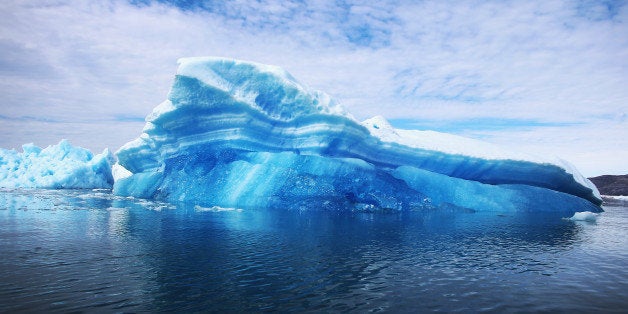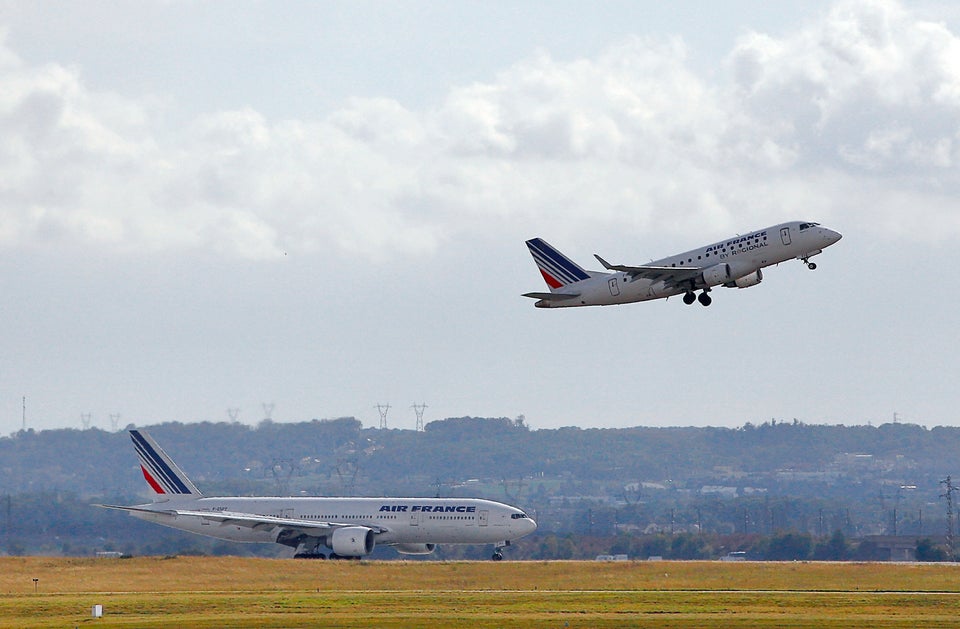
There's a lot of scary Halloween programming this month, but a new Weather Channel series might be the most frightening of all. “The Tipping Points: 6 Places on Earth Where Climate’s Changed” is scary because it’s real, showing what global warming will do to the planet if it proceeds at the current rate — starting with the Amazon rain forest, where drought, fires, changes in carbon dioxide, and loss of biodiversity due to climate change are converging with disastrous consequences.
Premiering Oct. 19, the series is hosted by polar explorer, former rafting instructor, and climate journalist and lecturer Bernice Notenboom, who holds an MBA and a master's degree in geography and communications science and who hopes to reach a wider audience via television. “Over the years I became more interested in reporting about climate change,” she tells MNN. With 'Tipping Points,' "My quest is to educate big audiences including children, businesses and general public."
MNN: How did you become involved in the series?
Bernice Notenboom: I met Liz Courtney of Unboxed Media in Toronto at the Planet in Focus film festival. A year later she called me and shared her idea about tipping points and asked me if I wanted to be involved. I had made films about climate change on the South Pole, Everest and in the desert of Mali before where we take extreme adventure, beautiful scenery and climate change in one package. Liz wanted to do a similar approach for “Tipping Points.” The difference with this series is that we travel with scientists who are in the field doing their research; the scientists are the focus and there’s less emphasis on the adventure part.
Why and how were these six places chosen?
We chose the locations based on Tim Lenton's theory of tipping points. He identified 12 tipping points, but phenomena's such as El Nino or the West African monsoon are difficult to visualize and to film. So we needed to focus on places where we can see the change and/or have scientists demonstrate what the change means if temperature continues to rise. Additionally, you need to be concerned about safety, ease of travel and the kind of adventure we can do with scientists to tell the story. The most important factor is to select locations where scientists are actively doing research relating to tipping points so we can travel with them and explain the causes that lead to changes in ecosystems due to climate change.
The first episode is about the Amazon rain forest. How close to the tipping point is it there, and do you think it can recover?
The Amazon has multiple threats which makes it complex to understand. Unlike ice — when temperatures increase it melts — the Amazon responds much slower to change. If drought hits the Amazon, it takes three years before you see trees responding. Deforestation is likely the biggest threat to the forests because it decreases rainfall and increases temperature. Big areas that have been cleared for agriculture and cattle are suffering from less precipitation and drought and are subject to fires. The Amazon is also sensitive to El Nino and La Nina and overall increase of temperature of the oceans. With each of them, there is simply more energy in the atmosphere due to evaporation but the rain ends up falling in the ocean and not on land, increasing drought cycles. The Amazon is also massive and straddles many countries. Brazil is influenced by the Atlantic Ocean, whereas Peru and Ecuador are more influenced by the Pacific Ocean. This means that some parts of the Amazon suffer drought while other areas are flooding. Planting trees and saving the rain forest is the best we can do to prevent a tipping point of the forest despite the increasing economic interests.
What other imperiled places are covered in the show? Where are they, and what are the specific global warming-created problems in each?
The Greenland icecap: Here we see the icecap is suffering from surface melt with increasing air temperature. This melt creates lakes that fill up and drain when they become too full. This melt water runs through old crevasses to the bottom of the icecap where it hits the bedrock surface and drains to the ocean dumping cold fresh water into the ocean. Lack of sea ice in Greenland also let the glaciers flow more freely since it is missing its protection. Glaciers are accelerating and calve more rapidly. Soot is another issue in Greenland. This black substance, coming from industries far away, rains on the glaciers and speeds up the melt because it traps the heat.
Permafrost above the Arctic Circle in Siberia, Canada and the United States is starting to thaw more rapidly. Warm polar air and cloudy nights trap heat in the atmosphere causing the permafrost to respond. When it thaws it can either release methane or carbon dioxide. Methane has 23 times more greenhouse gas than CO2, so if this thaws, we are creating a huge problem for ourselves and keeping global temperatures in check of 2 degrees becomes very unlikely.
The big Southern Ocean is getting less salty and losing its capacity to absorb more CO2. Since oceans take in as much as 42 percent of CO2, we need the oceans to be cold, dense and salty. Oceans are also getting more acidic, which affects the health of marine wildlife and coral reefs. Inhabitants of Tuvalu are suffering from salty groundwater and crops become difficult to grow. Those people may be the first ones to qualify as climate refugees.
In the Himalayas, the atmospheric brown cloud — pollution from coal fire power plants, diesel engines and burning wood — has created a cloud of three kilometers thick and is the size of the USA. This cloud spits soot on the glaciers (like Greenland) and hastens its melt. In the short term, there will be floods from melting glaciers, but then drought and lack of water will be the bigger issue. It will affect 3 billion people on Earth. This trapped heat of the cloud also has an impact on the Asian monsoon, which weakens its strength and brings less rains to the mountains and higher regions.
Africa has multiple potential tipping points at once. Increasing temperatures in the Sahara and lack of rain stimulate sand storms and dust events shielding the atmosphere. The African monsoon becomes unpredictable, bringing too much rain or too little to the poor people, depending on rain in the Sahel countries.
How severe are these problems and what is being done to counter them? What are some practical solutions?
Thawing permafrost is the biggest threat to all of us globally. This may mean a temperature spike of 4 degrees if all the permafrost thaws. We now also discover that lack of sea ice in the polar region may alter and slow down our jet stream, which can get stuck and creates extreme weather events especially in the winter.
The best thing we can do for our planet is to lower consumption and phase out of fossil fuels. This needs to happen on all levels: consumer, industries and in politics. Even the United Nations needs to get involved. Reducing our carbon footprint is such a humongous task and affects everyone; it is hard to say to someone in China or India he can't have the latest BMW model or vacation to a far away resort if this is their dream and they worked hard their entire lives to fulfill it. On the other hand, we have the technology and means to live more sustainably, but all we are lacking is the will power. Perhaps after a series of disasters, we will be forced to think differently. No matter what, it will be a huge price to pay and unfair to the people who had nothing to do with this.
What things did you learn from your participation that you didn't know before? Did it reassure you or scare you?
I didn't know the oceans play such a big role in the story of the tipping points. I knew that they are major engines for storing CO2 but subtle changes mean huge effects. It scares me to learn that the Great Southern Ocean is getting less salty and warmer, and that we know little about when this CO2 may get released back into the atmosphere when the oceans are becoming too saturated. I also feel confident we can fix the atmospheric brown cloud if we can get the pollution of diesel engines and cooking fires under control. Scientists say this may only take a year or less. The big question will be if it really helps the glaciers from melting too fast or if this will be too late once we get our act together.
Do you hope it scares viewers and prompt action? How so?
There is no doubt it will scare viewers; perhaps it scares them too much and they feel overwhelmed to do something. When I lecture I get the same response from the audience. We call this the prisoner’s dilemma: We are in the same boat and there is nothing we can do individually that makes a difference therefore we do nothing. Our purpose is to tell the story of climate change with tipping points, not to lecture or provide a gloom and doom scenario but simply from the perspective of being informed. I think people will learn in this series and being informed motivates you to take action. A common response is that "we know what climate change is, heard it all before," but to me this is where we can really make a difference because our series shows that scientists are frantically trying to find answers to new climate issues and the science of tipping points makes it so interesting.
What is the overall takeaway from this series?
I hope that people understand more about the science and what the scientists are actually doing in the field to understand the changes. Unfortunately, we are just at the base of understanding what some of these tipping elements mean and how they relate to each other. Research is expensive, and the locations remote and lots more research needs to happen. Climate change in the USA seems to be still a matter of belief, not with facts. What we hope to prove with this series is that this is happening to our planet and the scientists are proving it. Living for so long in a wilderness setting makes me appreciate nature even more, and I believe this is my personal premise to set out and educate people to protect this incredible planet we live on.
